Analyzing Diabetes in Aboriginal Australia: A Sociological Perspective
VerifiedAdded on 2022/09/18
|11
|2654
|47
Essay
AI Summary
This essay undertakes a comprehensive analysis of diabetes management within the Aboriginal and Torres Strait Islander communities in Australia, employing the sociological imagination framework. It begins by highlighting the disproportionately high prevalence of diabetes within this population, emphasizing the historical context of European colonization and its impact on traditional lifestyles and nutritional habits. The essay then delves into structural factors, such as socioeconomic disparities and inadequate infrastructure, which contribute to adverse health outcomes. Cultural factors, including beliefs, smoking habits, and lifestyle choices, are also examined for their influence on diabetes prevalence. The second part of the essay identifies key issues in diabetes management, including awareness, self-management practices, and access to healthcare. It discusses government policies and programs, such as the Aboriginal and Torres Strait Islanders Diabetes Action Plan and the Australian National Diabetes Strategy, aimed at addressing these issues. The essay also explores specific diabetes programs, like the Healthy for Life program and the Life! Program, designed to promote early detection, lifestyle modifications, and culturally relevant care. The essay concludes by reiterating the complex interplay of historical, cultural, structural, and critical factors in diabetes management, and the importance of culturally appropriate interventions.
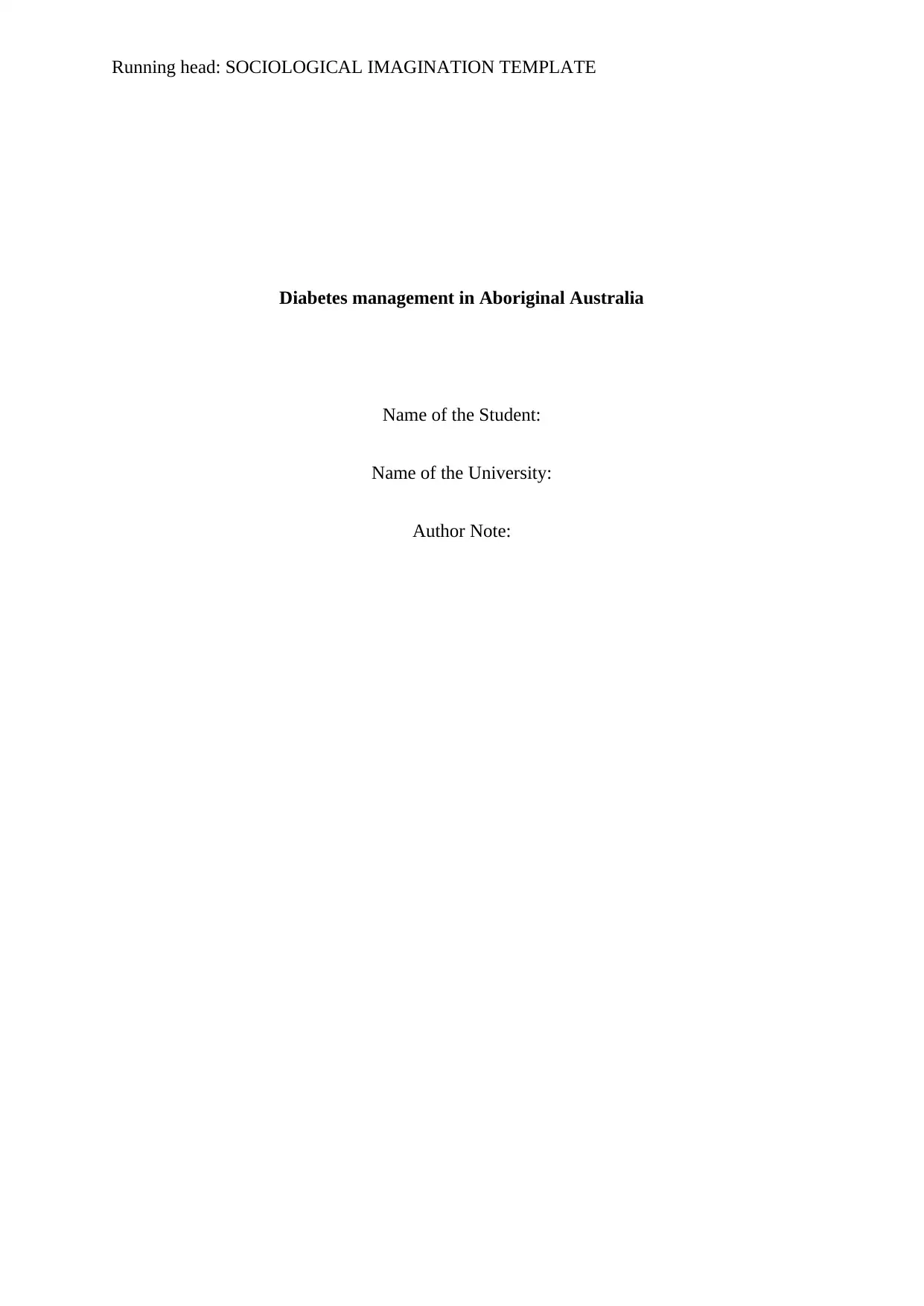
Running head: SOCIOLOGICAL IMAGINATION TEMPLATE
Diabetes management in Aboriginal Australia
Name of the Student:
Name of the University:
Author Note:
Diabetes management in Aboriginal Australia
Name of the Student:
Name of the University:
Author Note:
Paraphrase This Document
Need a fresh take? Get an instant paraphrase of this document with our AI Paraphraser
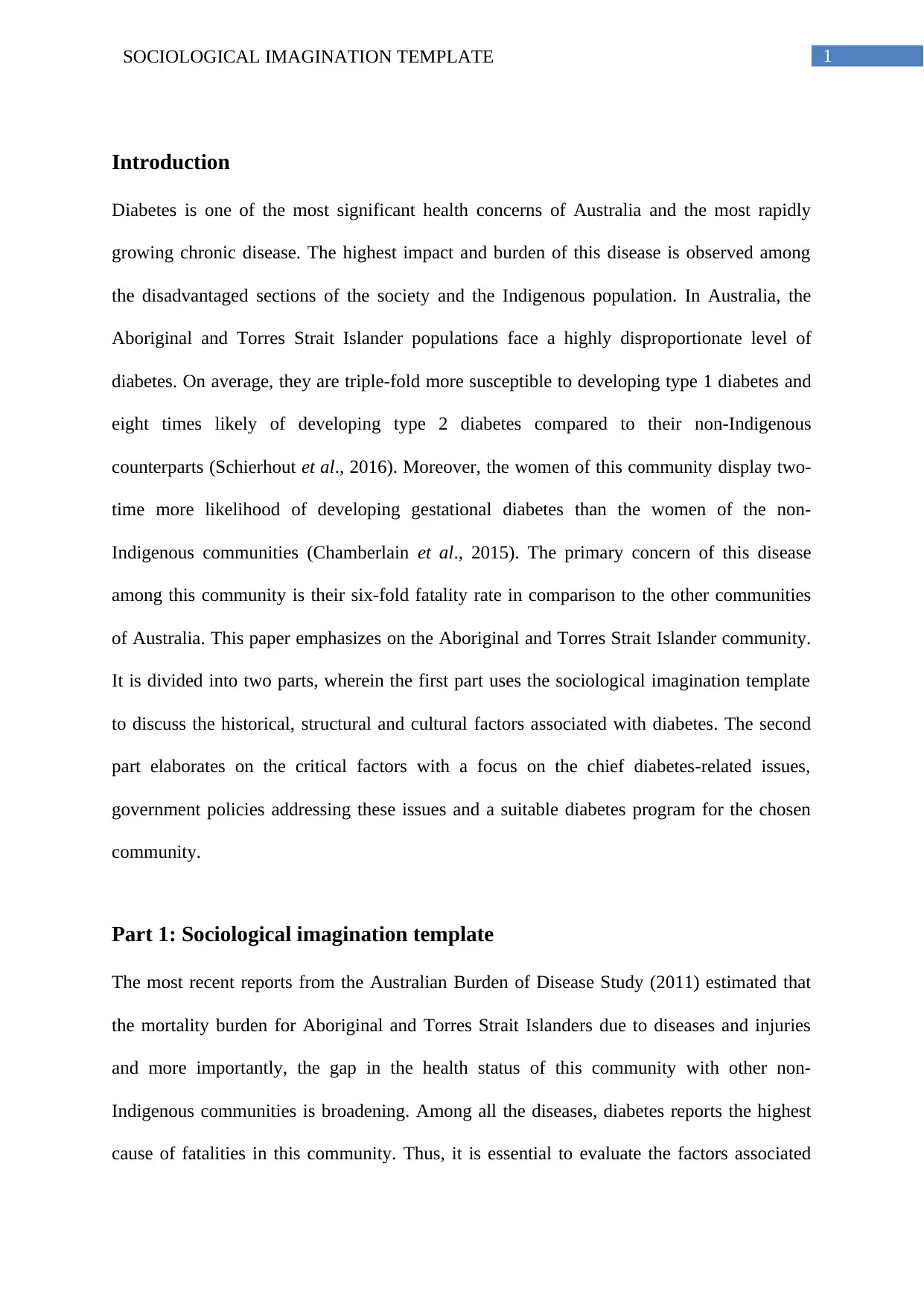
SOCIOLOGICAL IMAGINATION TEMPLATE 1
Introduction
Diabetes is one of the most significant health concerns of Australia and the most rapidly
growing chronic disease. The highest impact and burden of this disease is observed among
the disadvantaged sections of the society and the Indigenous population. In Australia, the
Aboriginal and Torres Strait Islander populations face a highly disproportionate level of
diabetes. On average, they are triple-fold more susceptible to developing type 1 diabetes and
eight times likely of developing type 2 diabetes compared to their non-Indigenous
counterparts (Schierhout et al., 2016). Moreover, the women of this community display two-
time more likelihood of developing gestational diabetes than the women of the non-
Indigenous communities (Chamberlain et al., 2015). The primary concern of this disease
among this community is their six-fold fatality rate in comparison to the other communities
of Australia. This paper emphasizes on the Aboriginal and Torres Strait Islander community.
It is divided into two parts, wherein the first part uses the sociological imagination template
to discuss the historical, structural and cultural factors associated with diabetes. The second
part elaborates on the critical factors with a focus on the chief diabetes-related issues,
government policies addressing these issues and a suitable diabetes program for the chosen
community.
Part 1: Sociological imagination template
The most recent reports from the Australian Burden of Disease Study (2011) estimated that
the mortality burden for Aboriginal and Torres Strait Islanders due to diseases and injuries
and more importantly, the gap in the health status of this community with other non-
Indigenous communities is broadening. Among all the diseases, diabetes reports the highest
cause of fatalities in this community. Thus, it is essential to evaluate the factors associated
Introduction
Diabetes is one of the most significant health concerns of Australia and the most rapidly
growing chronic disease. The highest impact and burden of this disease is observed among
the disadvantaged sections of the society and the Indigenous population. In Australia, the
Aboriginal and Torres Strait Islander populations face a highly disproportionate level of
diabetes. On average, they are triple-fold more susceptible to developing type 1 diabetes and
eight times likely of developing type 2 diabetes compared to their non-Indigenous
counterparts (Schierhout et al., 2016). Moreover, the women of this community display two-
time more likelihood of developing gestational diabetes than the women of the non-
Indigenous communities (Chamberlain et al., 2015). The primary concern of this disease
among this community is their six-fold fatality rate in comparison to the other communities
of Australia. This paper emphasizes on the Aboriginal and Torres Strait Islander community.
It is divided into two parts, wherein the first part uses the sociological imagination template
to discuss the historical, structural and cultural factors associated with diabetes. The second
part elaborates on the critical factors with a focus on the chief diabetes-related issues,
government policies addressing these issues and a suitable diabetes program for the chosen
community.
Part 1: Sociological imagination template
The most recent reports from the Australian Burden of Disease Study (2011) estimated that
the mortality burden for Aboriginal and Torres Strait Islanders due to diseases and injuries
and more importantly, the gap in the health status of this community with other non-
Indigenous communities is broadening. Among all the diseases, diabetes reports the highest
cause of fatalities in this community. Thus, it is essential to evaluate the factors associated

2SOCIOLOGICAL IMAGINATION TEMPLATE
with the increasing prevalence of diabetes specifically among this community. A holistic
approach for the evaluation of the factors is effective, which can be done by using the
sociological imagination template. This term was first coined by C. Wright and stated that a
majority of the social problems cannot be resolved by individual solution but require an
understanding of the historical, structural, cultural and critical factors associated with it
(Blommaert, 2018).
Historical factors
The people of Aboriginal and Torres Strait Islander descend and practice the primitive
lifestyle of hunter-gatherers for a long time extending up to the late 18th century. However,
with the Europeans’ arrival and colonization in 1788 resulted in significant lifestyle
modifications. Their traditional practices included the discovery of renewable resources and
food, maintenance of cultural and family traditions, and sustenance of their spiritual
connection to their country experienced changes with time. Besides, the changes observed in
their nutritional habits and physical activities served as chief risk factors for diabetes and its
increasing prevalence in Aboriginal and Torres Strait Islander populations, specifically in the
later phase of the 20th century (Sherwood & Geia, 2014). The early cases of diabetes among
the communities of Aboriginal and Torres Strait Islanders were reported in the year 1923 in
Adelaide. The health reports of the people of Aboriginal and Torres Strait Islanders before
this case demonstrated that the people were lean and fit, and suffered no particular metabolic
condition of the European origin. This suggested that the European colonization is a
significant historical factor associated with the development of diabetes within these
indigenous communities. Gradually, the prevalence of diabetes among these communities
rose exponentially and detailed investigations on the case began in the 1960s. These detailed
investigations resulted in the conclusion of direct correlation between the development of
diabetes and the adoption of Western-style habits of living, which include a shift from the
with the increasing prevalence of diabetes specifically among this community. A holistic
approach for the evaluation of the factors is effective, which can be done by using the
sociological imagination template. This term was first coined by C. Wright and stated that a
majority of the social problems cannot be resolved by individual solution but require an
understanding of the historical, structural, cultural and critical factors associated with it
(Blommaert, 2018).
Historical factors
The people of Aboriginal and Torres Strait Islander descend and practice the primitive
lifestyle of hunter-gatherers for a long time extending up to the late 18th century. However,
with the Europeans’ arrival and colonization in 1788 resulted in significant lifestyle
modifications. Their traditional practices included the discovery of renewable resources and
food, maintenance of cultural and family traditions, and sustenance of their spiritual
connection to their country experienced changes with time. Besides, the changes observed in
their nutritional habits and physical activities served as chief risk factors for diabetes and its
increasing prevalence in Aboriginal and Torres Strait Islander populations, specifically in the
later phase of the 20th century (Sherwood & Geia, 2014). The early cases of diabetes among
the communities of Aboriginal and Torres Strait Islanders were reported in the year 1923 in
Adelaide. The health reports of the people of Aboriginal and Torres Strait Islanders before
this case demonstrated that the people were lean and fit, and suffered no particular metabolic
condition of the European origin. This suggested that the European colonization is a
significant historical factor associated with the development of diabetes within these
indigenous communities. Gradually, the prevalence of diabetes among these communities
rose exponentially and detailed investigations on the case began in the 1960s. These detailed
investigations resulted in the conclusion of direct correlation between the development of
diabetes and the adoption of Western-style habits of living, which include a shift from the
⊘ This is a preview!⊘
Do you want full access?
Subscribe today to unlock all pages.

Trusted by 1+ million students worldwide

3SOCIOLOGICAL IMAGINATION TEMPLATE
traditional nutrition-rich food habits to ultra-processed and fast foods of the Western culture
(Al-Yaman, 2017).
Structural factors
Socioeconomic divisions in the structure of the society expose the marginalized and socially
disadvantaged sections of the society to adverse health outcomes. These health disparities are
widespread and an essential factor for the growing incidence of diabetes among the
communities of Aboriginal and Torres Strait Islander. These communities lack inadequate
structural infrastructure, which broadly includes physical infrastructure, economic
opportunities and social conditions (Singh, 2018). The physical infrastructure of this
community is deficient in their housing and living conditions, and access to health care
setting and facilities, which are potential reasons for an elevated exposure to unhealthy
conditions. Secondly, the economic opportunities available to these communities is not
equitable and face significant barriers. The employment scope and family incomes are below
average for a majority of the community, leading to reduced standards of living. Lastly, the
social conditions of these communities are also not up to the level of their other counterparts.
Poor social conditions such as racism, incarceration and devotion to their lands are potential
structural factors associated with diabetes.
Cultural factors
The culture is regarded as the primary factor of determining health to an Indigenous outlook
on life, and hence, critically influence the health status and behaviours of the community. The
cultural beliefs of the people of Aboriginal and Torres Strait Islander believe in the
connection of the prevalence of diabetes with family history or kinship group. The trends of
tobacco smoking among the community is a major cultural factor associated with the growing
incidence of diabetes. A study conducted on the Aboriginal and Torres Strait Islanders
traditional nutrition-rich food habits to ultra-processed and fast foods of the Western culture
(Al-Yaman, 2017).
Structural factors
Socioeconomic divisions in the structure of the society expose the marginalized and socially
disadvantaged sections of the society to adverse health outcomes. These health disparities are
widespread and an essential factor for the growing incidence of diabetes among the
communities of Aboriginal and Torres Strait Islander. These communities lack inadequate
structural infrastructure, which broadly includes physical infrastructure, economic
opportunities and social conditions (Singh, 2018). The physical infrastructure of this
community is deficient in their housing and living conditions, and access to health care
setting and facilities, which are potential reasons for an elevated exposure to unhealthy
conditions. Secondly, the economic opportunities available to these communities is not
equitable and face significant barriers. The employment scope and family incomes are below
average for a majority of the community, leading to reduced standards of living. Lastly, the
social conditions of these communities are also not up to the level of their other counterparts.
Poor social conditions such as racism, incarceration and devotion to their lands are potential
structural factors associated with diabetes.
Cultural factors
The culture is regarded as the primary factor of determining health to an Indigenous outlook
on life, and hence, critically influence the health status and behaviours of the community. The
cultural beliefs of the people of Aboriginal and Torres Strait Islander believe in the
connection of the prevalence of diabetes with family history or kinship group. The trends of
tobacco smoking among the community is a major cultural factor associated with the growing
incidence of diabetes. A study conducted on the Aboriginal and Torres Strait Islanders
Paraphrase This Document
Need a fresh take? Get an instant paraphrase of this document with our AI Paraphraser
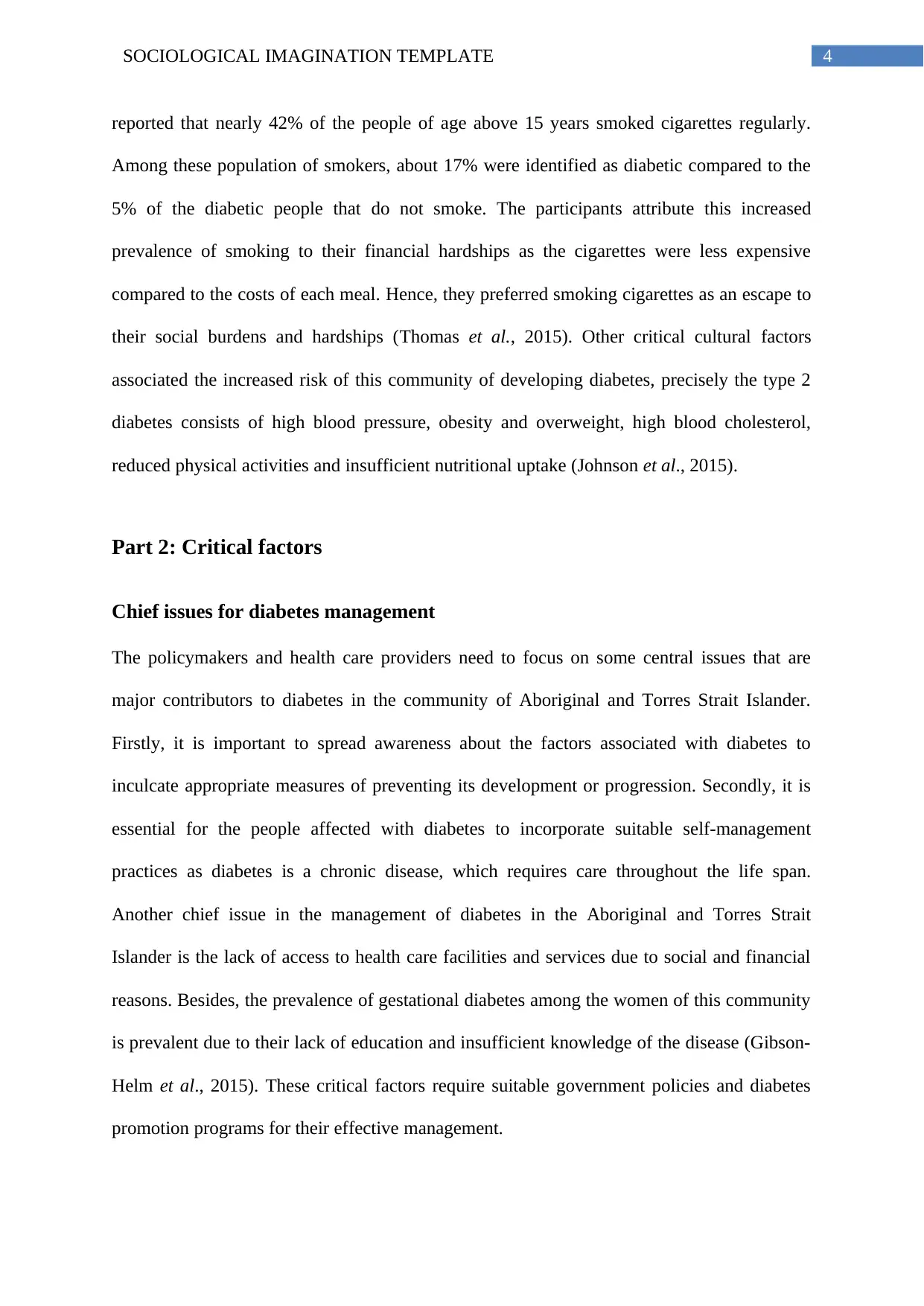
4SOCIOLOGICAL IMAGINATION TEMPLATE
reported that nearly 42% of the people of age above 15 years smoked cigarettes regularly.
Among these population of smokers, about 17% were identified as diabetic compared to the
5% of the diabetic people that do not smoke. The participants attribute this increased
prevalence of smoking to their financial hardships as the cigarettes were less expensive
compared to the costs of each meal. Hence, they preferred smoking cigarettes as an escape to
their social burdens and hardships (Thomas et al., 2015). Other critical cultural factors
associated the increased risk of this community of developing diabetes, precisely the type 2
diabetes consists of high blood pressure, obesity and overweight, high blood cholesterol,
reduced physical activities and insufficient nutritional uptake (Johnson et al., 2015).
Part 2: Critical factors
Chief issues for diabetes management
The policymakers and health care providers need to focus on some central issues that are
major contributors to diabetes in the community of Aboriginal and Torres Strait Islander.
Firstly, it is important to spread awareness about the factors associated with diabetes to
inculcate appropriate measures of preventing its development or progression. Secondly, it is
essential for the people affected with diabetes to incorporate suitable self-management
practices as diabetes is a chronic disease, which requires care throughout the life span.
Another chief issue in the management of diabetes in the Aboriginal and Torres Strait
Islander is the lack of access to health care facilities and services due to social and financial
reasons. Besides, the prevalence of gestational diabetes among the women of this community
is prevalent due to their lack of education and insufficient knowledge of the disease (Gibson-
Helm et al., 2015). These critical factors require suitable government policies and diabetes
promotion programs for their effective management.
reported that nearly 42% of the people of age above 15 years smoked cigarettes regularly.
Among these population of smokers, about 17% were identified as diabetic compared to the
5% of the diabetic people that do not smoke. The participants attribute this increased
prevalence of smoking to their financial hardships as the cigarettes were less expensive
compared to the costs of each meal. Hence, they preferred smoking cigarettes as an escape to
their social burdens and hardships (Thomas et al., 2015). Other critical cultural factors
associated the increased risk of this community of developing diabetes, precisely the type 2
diabetes consists of high blood pressure, obesity and overweight, high blood cholesterol,
reduced physical activities and insufficient nutritional uptake (Johnson et al., 2015).
Part 2: Critical factors
Chief issues for diabetes management
The policymakers and health care providers need to focus on some central issues that are
major contributors to diabetes in the community of Aboriginal and Torres Strait Islander.
Firstly, it is important to spread awareness about the factors associated with diabetes to
inculcate appropriate measures of preventing its development or progression. Secondly, it is
essential for the people affected with diabetes to incorporate suitable self-management
practices as diabetes is a chronic disease, which requires care throughout the life span.
Another chief issue in the management of diabetes in the Aboriginal and Torres Strait
Islander is the lack of access to health care facilities and services due to social and financial
reasons. Besides, the prevalence of gestational diabetes among the women of this community
is prevalent due to their lack of education and insufficient knowledge of the disease (Gibson-
Helm et al., 2015). These critical factors require suitable government policies and diabetes
promotion programs for their effective management.
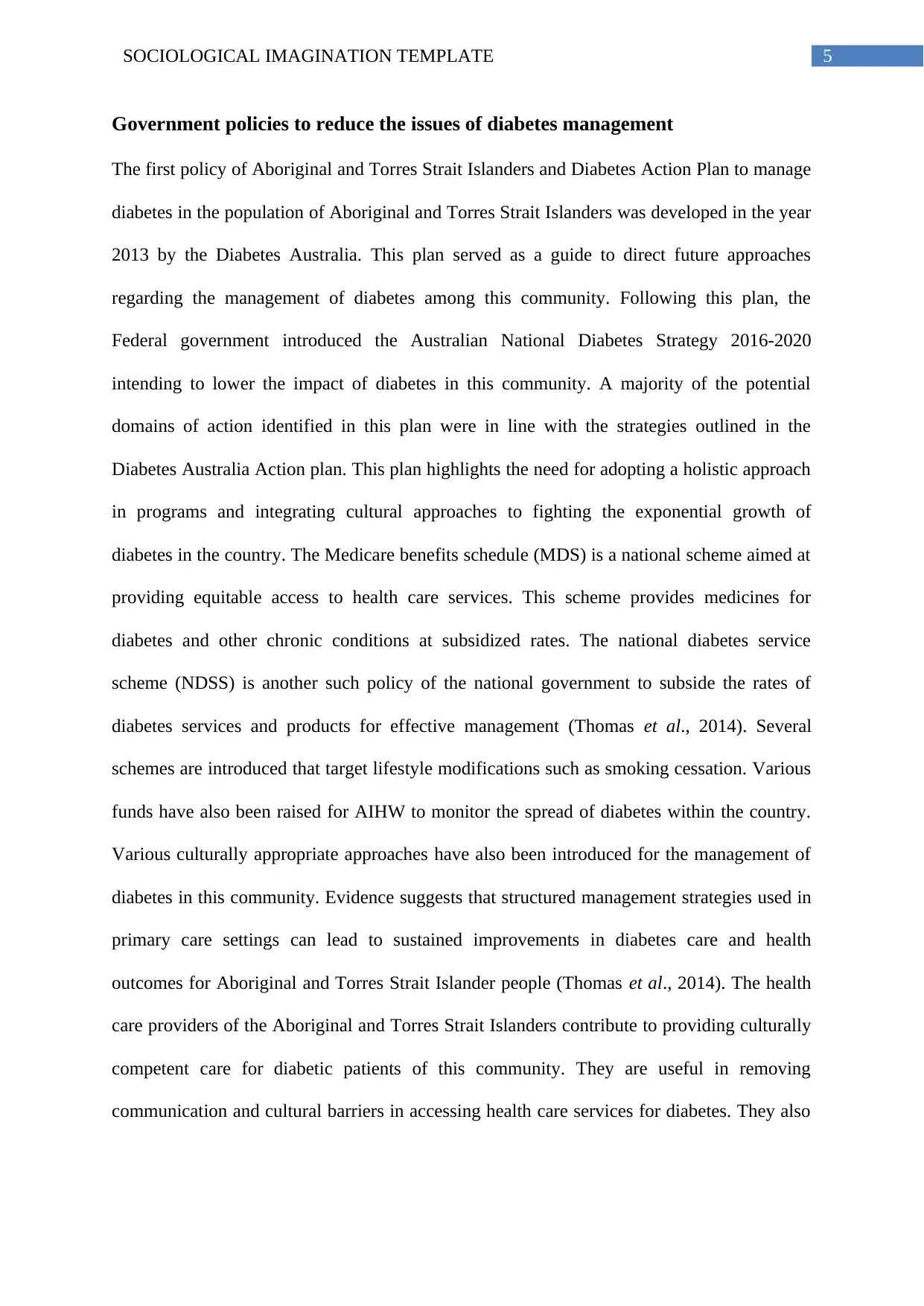
5SOCIOLOGICAL IMAGINATION TEMPLATE
Government policies to reduce the issues of diabetes management
The first policy of Aboriginal and Torres Strait Islanders and Diabetes Action Plan to manage
diabetes in the population of Aboriginal and Torres Strait Islanders was developed in the year
2013 by the Diabetes Australia. This plan served as a guide to direct future approaches
regarding the management of diabetes among this community. Following this plan, the
Federal government introduced the Australian National Diabetes Strategy 2016-2020
intending to lower the impact of diabetes in this community. A majority of the potential
domains of action identified in this plan were in line with the strategies outlined in the
Diabetes Australia Action plan. This plan highlights the need for adopting a holistic approach
in programs and integrating cultural approaches to fighting the exponential growth of
diabetes in the country. The Medicare benefits schedule (MDS) is a national scheme aimed at
providing equitable access to health care services. This scheme provides medicines for
diabetes and other chronic conditions at subsidized rates. The national diabetes service
scheme (NDSS) is another such policy of the national government to subside the rates of
diabetes services and products for effective management (Thomas et al., 2014). Several
schemes are introduced that target lifestyle modifications such as smoking cessation. Various
funds have also been raised for AIHW to monitor the spread of diabetes within the country.
Various culturally appropriate approaches have also been introduced for the management of
diabetes in this community. Evidence suggests that structured management strategies used in
primary care settings can lead to sustained improvements in diabetes care and health
outcomes for Aboriginal and Torres Strait Islander people (Thomas et al., 2014). The health
care providers of the Aboriginal and Torres Strait Islanders contribute to providing culturally
competent care for diabetic patients of this community. They are useful in removing
communication and cultural barriers in accessing health care services for diabetes. They also
Government policies to reduce the issues of diabetes management
The first policy of Aboriginal and Torres Strait Islanders and Diabetes Action Plan to manage
diabetes in the population of Aboriginal and Torres Strait Islanders was developed in the year
2013 by the Diabetes Australia. This plan served as a guide to direct future approaches
regarding the management of diabetes among this community. Following this plan, the
Federal government introduced the Australian National Diabetes Strategy 2016-2020
intending to lower the impact of diabetes in this community. A majority of the potential
domains of action identified in this plan were in line with the strategies outlined in the
Diabetes Australia Action plan. This plan highlights the need for adopting a holistic approach
in programs and integrating cultural approaches to fighting the exponential growth of
diabetes in the country. The Medicare benefits schedule (MDS) is a national scheme aimed at
providing equitable access to health care services. This scheme provides medicines for
diabetes and other chronic conditions at subsidized rates. The national diabetes service
scheme (NDSS) is another such policy of the national government to subside the rates of
diabetes services and products for effective management (Thomas et al., 2014). Several
schemes are introduced that target lifestyle modifications such as smoking cessation. Various
funds have also been raised for AIHW to monitor the spread of diabetes within the country.
Various culturally appropriate approaches have also been introduced for the management of
diabetes in this community. Evidence suggests that structured management strategies used in
primary care settings can lead to sustained improvements in diabetes care and health
outcomes for Aboriginal and Torres Strait Islander people (Thomas et al., 2014). The health
care providers of the Aboriginal and Torres Strait Islanders contribute to providing culturally
competent care for diabetic patients of this community. They are useful in removing
communication and cultural barriers in accessing health care services for diabetes. They also
⊘ This is a preview!⊘
Do you want full access?
Subscribe today to unlock all pages.

Trusted by 1+ million students worldwide
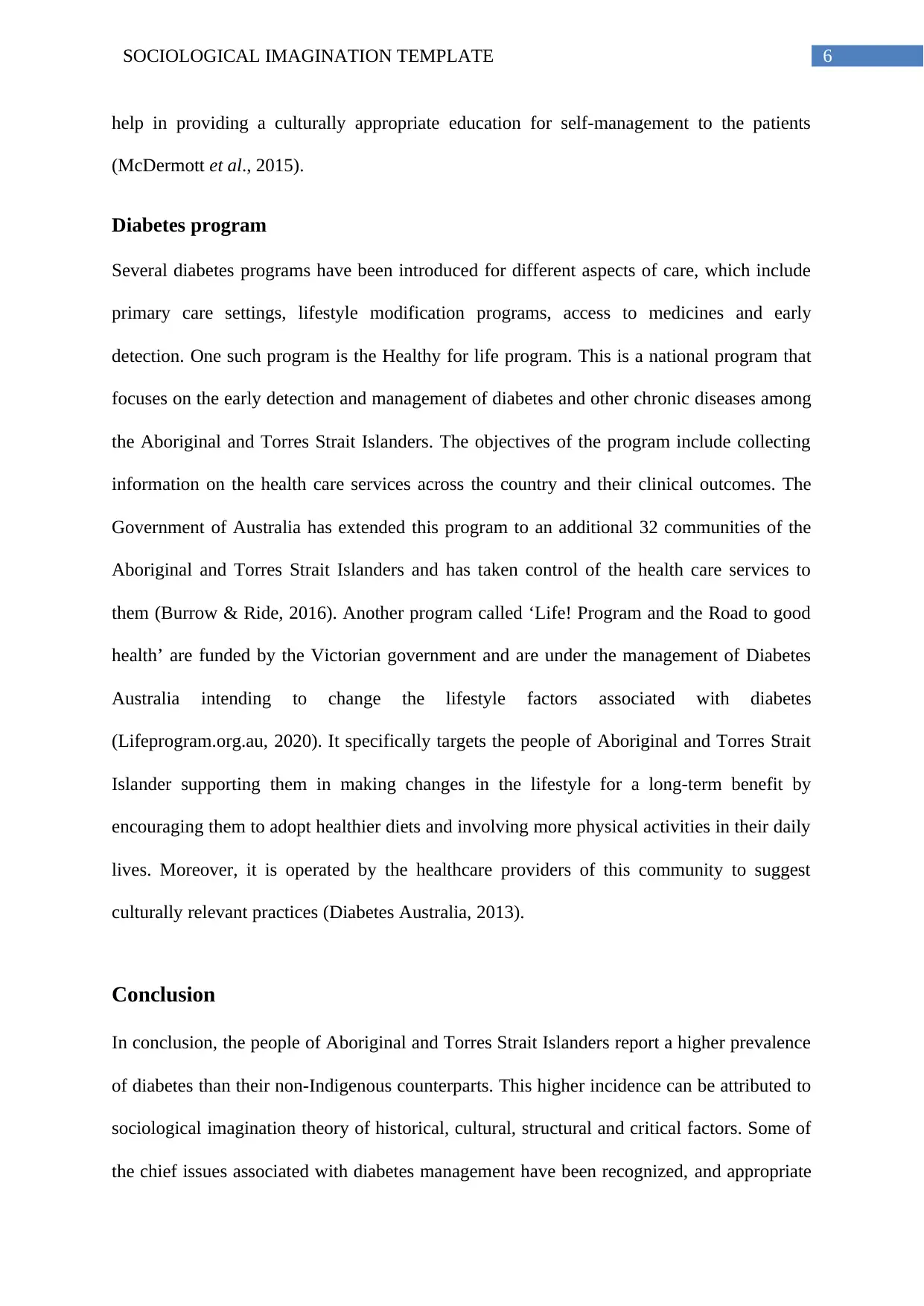
6SOCIOLOGICAL IMAGINATION TEMPLATE
help in providing a culturally appropriate education for self-management to the patients
(McDermott et al., 2015).
Diabetes program
Several diabetes programs have been introduced for different aspects of care, which include
primary care settings, lifestyle modification programs, access to medicines and early
detection. One such program is the Healthy for life program. This is a national program that
focuses on the early detection and management of diabetes and other chronic diseases among
the Aboriginal and Torres Strait Islanders. The objectives of the program include collecting
information on the health care services across the country and their clinical outcomes. The
Government of Australia has extended this program to an additional 32 communities of the
Aboriginal and Torres Strait Islanders and has taken control of the health care services to
them (Burrow & Ride, 2016). Another program called ‘Life! Program and the Road to good
health’ are funded by the Victorian government and are under the management of Diabetes
Australia intending to change the lifestyle factors associated with diabetes
(Lifeprogram.org.au, 2020). It specifically targets the people of Aboriginal and Torres Strait
Islander supporting them in making changes in the lifestyle for a long-term benefit by
encouraging them to adopt healthier diets and involving more physical activities in their daily
lives. Moreover, it is operated by the healthcare providers of this community to suggest
culturally relevant practices (Diabetes Australia, 2013).
Conclusion
In conclusion, the people of Aboriginal and Torres Strait Islanders report a higher prevalence
of diabetes than their non-Indigenous counterparts. This higher incidence can be attributed to
sociological imagination theory of historical, cultural, structural and critical factors. Some of
the chief issues associated with diabetes management have been recognized, and appropriate
help in providing a culturally appropriate education for self-management to the patients
(McDermott et al., 2015).
Diabetes program
Several diabetes programs have been introduced for different aspects of care, which include
primary care settings, lifestyle modification programs, access to medicines and early
detection. One such program is the Healthy for life program. This is a national program that
focuses on the early detection and management of diabetes and other chronic diseases among
the Aboriginal and Torres Strait Islanders. The objectives of the program include collecting
information on the health care services across the country and their clinical outcomes. The
Government of Australia has extended this program to an additional 32 communities of the
Aboriginal and Torres Strait Islanders and has taken control of the health care services to
them (Burrow & Ride, 2016). Another program called ‘Life! Program and the Road to good
health’ are funded by the Victorian government and are under the management of Diabetes
Australia intending to change the lifestyle factors associated with diabetes
(Lifeprogram.org.au, 2020). It specifically targets the people of Aboriginal and Torres Strait
Islander supporting them in making changes in the lifestyle for a long-term benefit by
encouraging them to adopt healthier diets and involving more physical activities in their daily
lives. Moreover, it is operated by the healthcare providers of this community to suggest
culturally relevant practices (Diabetes Australia, 2013).
Conclusion
In conclusion, the people of Aboriginal and Torres Strait Islanders report a higher prevalence
of diabetes than their non-Indigenous counterparts. This higher incidence can be attributed to
sociological imagination theory of historical, cultural, structural and critical factors. Some of
the chief issues associated with diabetes management have been recognized, and appropriate
Paraphrase This Document
Need a fresh take? Get an instant paraphrase of this document with our AI Paraphraser
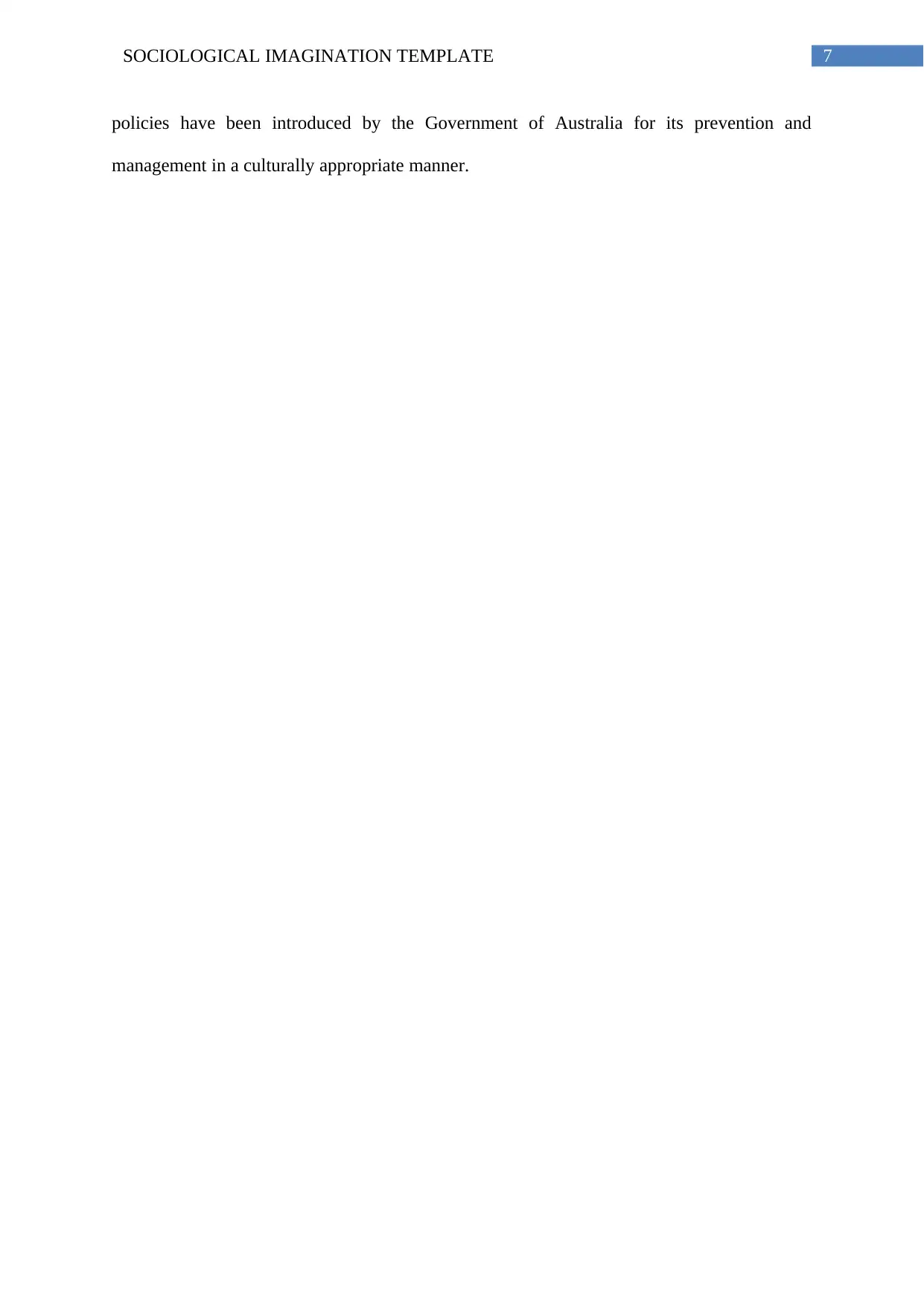
7SOCIOLOGICAL IMAGINATION TEMPLATE
policies have been introduced by the Government of Australia for its prevention and
management in a culturally appropriate manner.
policies have been introduced by the Government of Australia for its prevention and
management in a culturally appropriate manner.

8SOCIOLOGICAL IMAGINATION TEMPLATE
References
Al-Yaman, F. (2017). The Australian Burden of Disease Study: impact and causes of illness
and death in Aboriginal and Torres Strait Islander people, 2011. Public Health Res
Pract, 27(4), e2741732. https://doi.org/10.17061/phrp2741732
Blommaert, J. (2018). Durkheim and the internet: On sociolinguistics and the sociological
imagination. Bloomsbury Publishing.
Burrow, S., & Ride, K. (2016). Review of diabetes among Aboriginal and Torres Strait
Islander people. https://ro.ecu.edu.au/ecuworkspost2013/2226
Chamberlain, C., Joshy, G., Li, H., Oats, J., Eades, S., & Banks, E. (2015). The prevalence of
gestational diabetes mellitus among Aboriginal and Torres Strait Islander women in
Australia: a systematic review and meta‐analysis. Diabetes/metabolism research and
reviews, 31(3), 234-247. https://doi.org/10.1002/dmrr.2570
Diabetes Australia. (2013). Aboriginal and Torres Strait Islanders and diabetes action
plan. Canberra: Diabetes Australia National Office, 2-17.
Gibson-Helm, M. E., Rumbold, A. R., Teede, H. J., Ranasinha, S., Bailie, R. S., & Boyle, J.
A. (2016). Improving the provision of pregnancy care for Aboriginal and Torres Strait
Islander women: a continuous quality improvement initiative. BMC pregnancy and
childbirth, 16(1), 118. https://doi.org/10.1186/s12884-016-0892-1
Johnson, D. R., McDermott, R. A., Clifton, P. M., D’Onise, K., Taylor, S. M., Preece, C. L.,
& Schmidt, B. A. (2015). Characteristics of Indigenous adults with poorly controlled
diabetes in north Queensland: implications for services. BMC public health, 15(1),
325. https://doi.org/10.1186/s12889-015-1660-2
References
Al-Yaman, F. (2017). The Australian Burden of Disease Study: impact and causes of illness
and death in Aboriginal and Torres Strait Islander people, 2011. Public Health Res
Pract, 27(4), e2741732. https://doi.org/10.17061/phrp2741732
Blommaert, J. (2018). Durkheim and the internet: On sociolinguistics and the sociological
imagination. Bloomsbury Publishing.
Burrow, S., & Ride, K. (2016). Review of diabetes among Aboriginal and Torres Strait
Islander people. https://ro.ecu.edu.au/ecuworkspost2013/2226
Chamberlain, C., Joshy, G., Li, H., Oats, J., Eades, S., & Banks, E. (2015). The prevalence of
gestational diabetes mellitus among Aboriginal and Torres Strait Islander women in
Australia: a systematic review and meta‐analysis. Diabetes/metabolism research and
reviews, 31(3), 234-247. https://doi.org/10.1002/dmrr.2570
Diabetes Australia. (2013). Aboriginal and Torres Strait Islanders and diabetes action
plan. Canberra: Diabetes Australia National Office, 2-17.
Gibson-Helm, M. E., Rumbold, A. R., Teede, H. J., Ranasinha, S., Bailie, R. S., & Boyle, J.
A. (2016). Improving the provision of pregnancy care for Aboriginal and Torres Strait
Islander women: a continuous quality improvement initiative. BMC pregnancy and
childbirth, 16(1), 118. https://doi.org/10.1186/s12884-016-0892-1
Johnson, D. R., McDermott, R. A., Clifton, P. M., D’Onise, K., Taylor, S. M., Preece, C. L.,
& Schmidt, B. A. (2015). Characteristics of Indigenous adults with poorly controlled
diabetes in north Queensland: implications for services. BMC public health, 15(1),
325. https://doi.org/10.1186/s12889-015-1660-2
⊘ This is a preview!⊘
Do you want full access?
Subscribe today to unlock all pages.

Trusted by 1+ million students worldwide
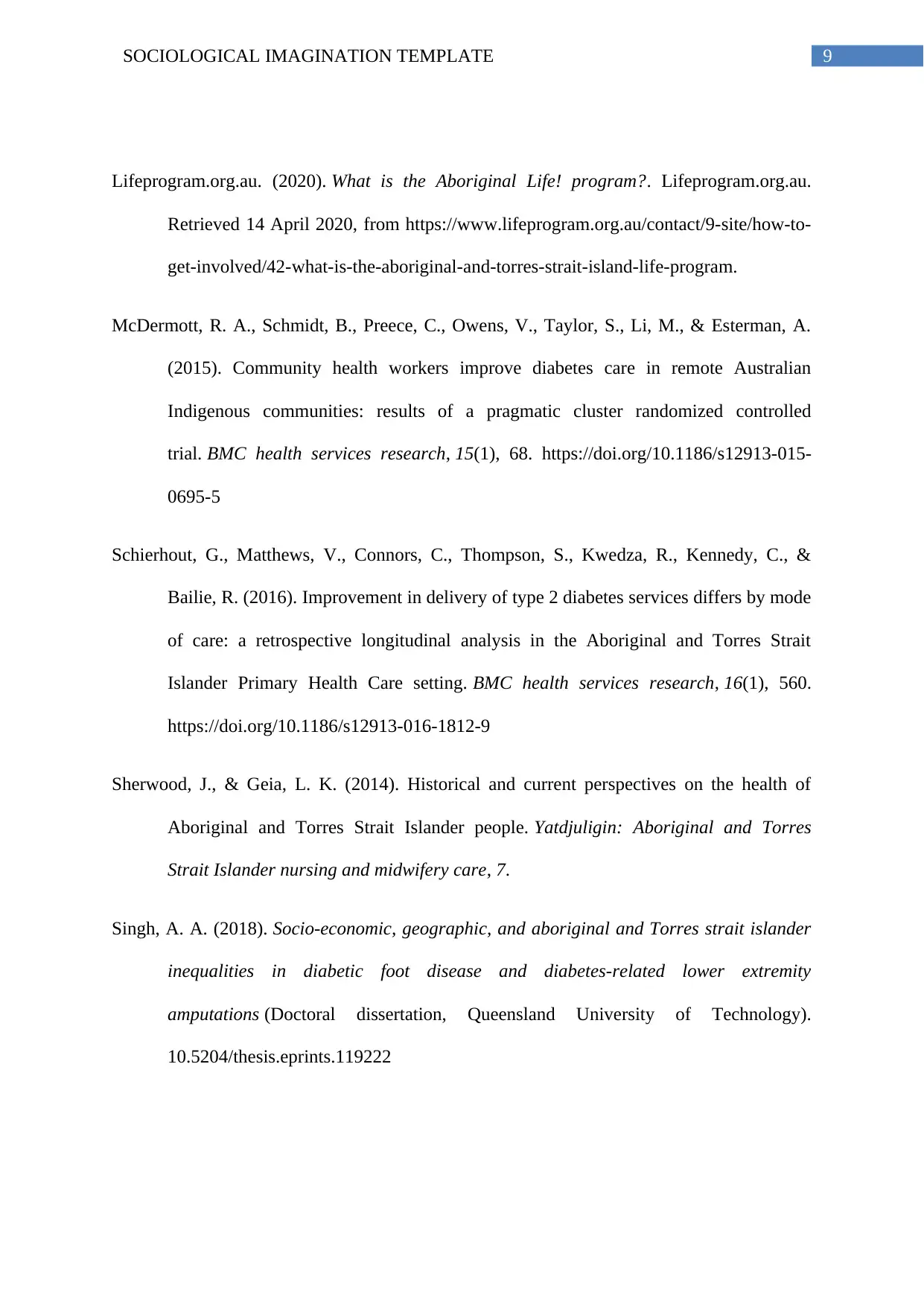
9SOCIOLOGICAL IMAGINATION TEMPLATE
Lifeprogram.org.au. (2020). What is the Aboriginal Life! program?. Lifeprogram.org.au.
Retrieved 14 April 2020, from https://www.lifeprogram.org.au/contact/9-site/how-to-
get-involved/42-what-is-the-aboriginal-and-torres-strait-island-life-program.
McDermott, R. A., Schmidt, B., Preece, C., Owens, V., Taylor, S., Li, M., & Esterman, A.
(2015). Community health workers improve diabetes care in remote Australian
Indigenous communities: results of a pragmatic cluster randomized controlled
trial. BMC health services research, 15(1), 68. https://doi.org/10.1186/s12913-015-
0695-5
Schierhout, G., Matthews, V., Connors, C., Thompson, S., Kwedza, R., Kennedy, C., &
Bailie, R. (2016). Improvement in delivery of type 2 diabetes services differs by mode
of care: a retrospective longitudinal analysis in the Aboriginal and Torres Strait
Islander Primary Health Care setting. BMC health services research, 16(1), 560.
https://doi.org/10.1186/s12913-016-1812-9
Sherwood, J., & Geia, L. K. (2014). Historical and current perspectives on the health of
Aboriginal and Torres Strait Islander people. Yatdjuligin: Aboriginal and Torres
Strait Islander nursing and midwifery care, 7.
Singh, A. A. (2018). Socio-economic, geographic, and aboriginal and Torres strait islander
inequalities in diabetic foot disease and diabetes-related lower extremity
amputations (Doctoral dissertation, Queensland University of Technology).
10.5204/thesis.eprints.119222
Lifeprogram.org.au. (2020). What is the Aboriginal Life! program?. Lifeprogram.org.au.
Retrieved 14 April 2020, from https://www.lifeprogram.org.au/contact/9-site/how-to-
get-involved/42-what-is-the-aboriginal-and-torres-strait-island-life-program.
McDermott, R. A., Schmidt, B., Preece, C., Owens, V., Taylor, S., Li, M., & Esterman, A.
(2015). Community health workers improve diabetes care in remote Australian
Indigenous communities: results of a pragmatic cluster randomized controlled
trial. BMC health services research, 15(1), 68. https://doi.org/10.1186/s12913-015-
0695-5
Schierhout, G., Matthews, V., Connors, C., Thompson, S., Kwedza, R., Kennedy, C., &
Bailie, R. (2016). Improvement in delivery of type 2 diabetes services differs by mode
of care: a retrospective longitudinal analysis in the Aboriginal and Torres Strait
Islander Primary Health Care setting. BMC health services research, 16(1), 560.
https://doi.org/10.1186/s12913-016-1812-9
Sherwood, J., & Geia, L. K. (2014). Historical and current perspectives on the health of
Aboriginal and Torres Strait Islander people. Yatdjuligin: Aboriginal and Torres
Strait Islander nursing and midwifery care, 7.
Singh, A. A. (2018). Socio-economic, geographic, and aboriginal and Torres strait islander
inequalities in diabetic foot disease and diabetes-related lower extremity
amputations (Doctoral dissertation, Queensland University of Technology).
10.5204/thesis.eprints.119222
Paraphrase This Document
Need a fresh take? Get an instant paraphrase of this document with our AI Paraphraser
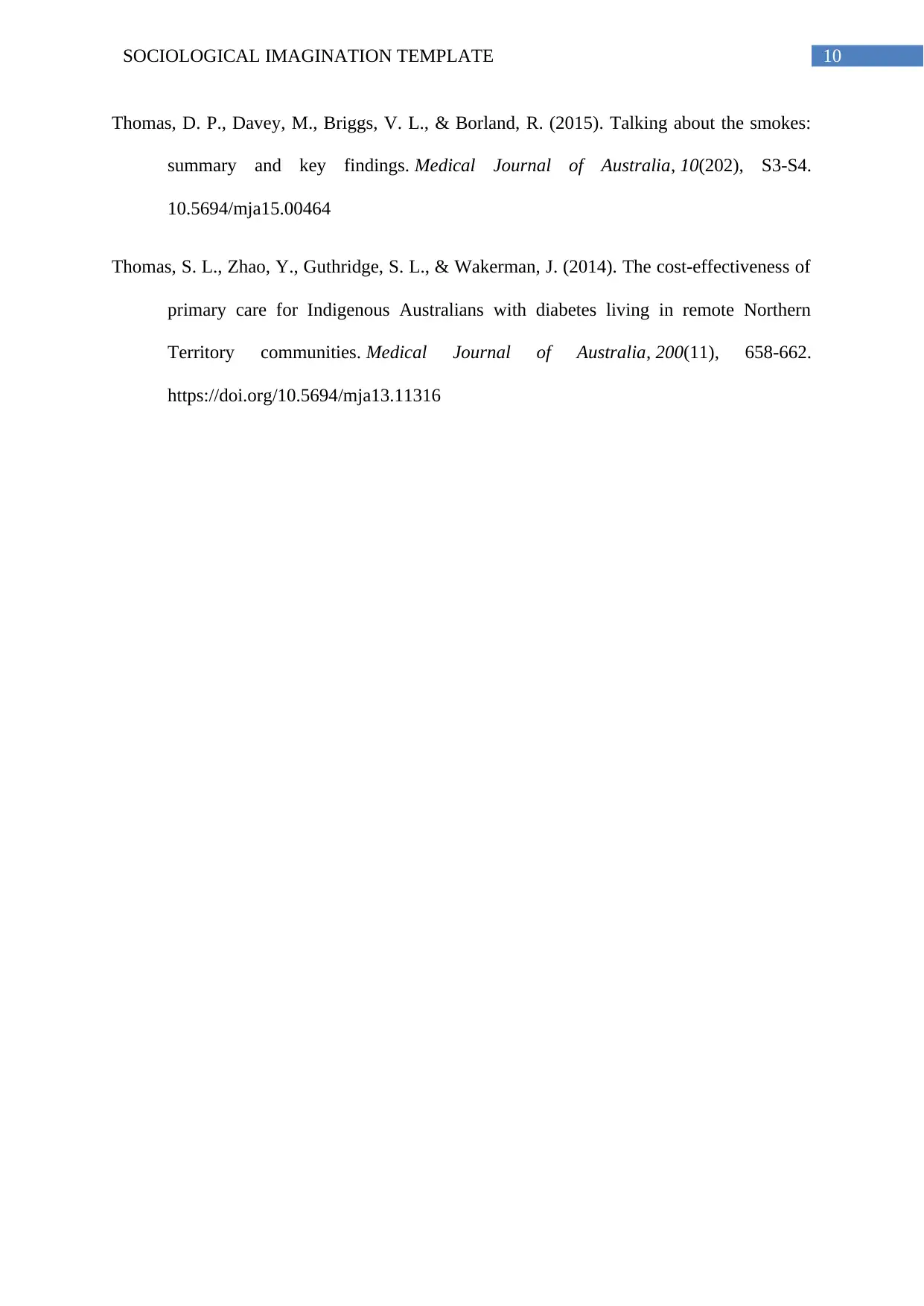
10SOCIOLOGICAL IMAGINATION TEMPLATE
Thomas, D. P., Davey, M., Briggs, V. L., & Borland, R. (2015). Talking about the smokes:
summary and key findings. Medical Journal of Australia, 10(202), S3-S4.
10.5694/mja15.00464
Thomas, S. L., Zhao, Y., Guthridge, S. L., & Wakerman, J. (2014). The cost‐effectiveness of
primary care for Indigenous Australians with diabetes living in remote Northern
Territory communities. Medical Journal of Australia, 200(11), 658-662.
https://doi.org/10.5694/mja13.11316
Thomas, D. P., Davey, M., Briggs, V. L., & Borland, R. (2015). Talking about the smokes:
summary and key findings. Medical Journal of Australia, 10(202), S3-S4.
10.5694/mja15.00464
Thomas, S. L., Zhao, Y., Guthridge, S. L., & Wakerman, J. (2014). The cost‐effectiveness of
primary care for Indigenous Australians with diabetes living in remote Northern
Territory communities. Medical Journal of Australia, 200(11), 658-662.
https://doi.org/10.5694/mja13.11316
1 out of 11
Related Documents
Your All-in-One AI-Powered Toolkit for Academic Success.
+13062052269
info@desklib.com
Available 24*7 on WhatsApp / Email
![[object Object]](/_next/static/media/star-bottom.7253800d.svg)
Unlock your academic potential
Copyright © 2020–2025 A2Z Services. All Rights Reserved. Developed and managed by ZUCOL.





